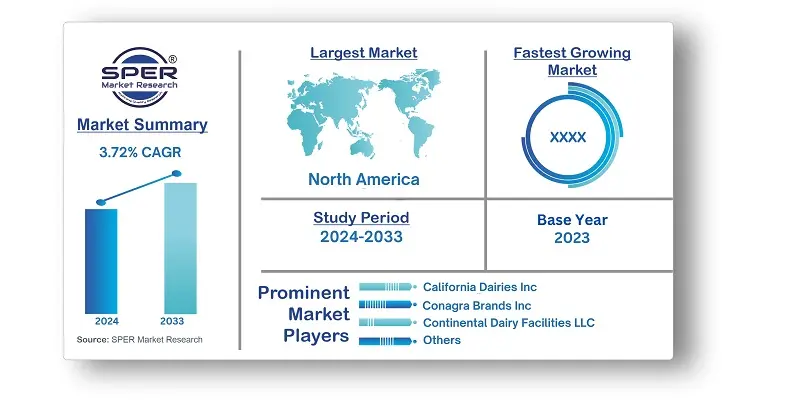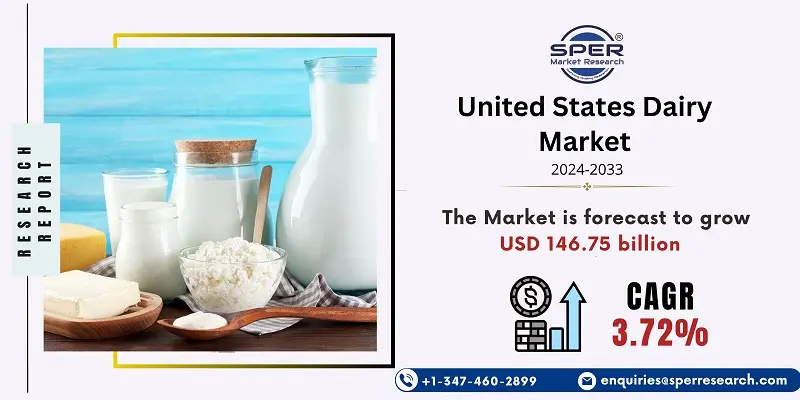
United States Dairy Market Growth, Size, Trends, Demand, Share, Revenue and Future Competition
United States Dairy Market Size- By Category, By Distribution Channel- Regional Outlook, Competitive Strategies and Segment Forecast to 2033
| Published: Jun-2024 | Report ID: FOOD2461 | Pages: 1 - 103 | Formats*: |
| Category : Food & Beverages | |||
- December 2022: Kraft Heinz's Canadian Grated Cheese division was acquired by Lactalis Canada, launching the company into the ambient market.
- August 2022: Dairy Farmers of America purchased two SmithFoods shelf-extended facilities. The purpose of this acquisition was to help the company take advantage of the expanding market for products with longer shelf life.


| Report Metric | Details |
| Market size available for years | 2020-2033 |
| Base year considered | 2023 |
| Forecast period | 2024-2033 |
| Segments covered | By Category, By Distribution Channel |
| Regions covered | Eastern, Western, Northern, Southern |
| Companies Covered | California Dairies Inc., Conagra Brands Inc., Continental Dairy Facilities LLC, Dairy Farmers of America Inc., Danone SA, Froneri International Limited, Groupe Lactalis, Land O'Lakes Inc., Nestlé SA, Prairie Farms Dairy Inc., Schreiber Foods Inc. |
- Food Retailers
- Food Service Providers
- Dairy Processors
- Dairy Farmers
- Institutional Buyers
- Food Manufacturers
| By Category: |
|
| By Distribution Channel: |
|
- United States Dairy Market Size (FY’2024-FY’2033)
- Overview of United States Dairy Market
- Segmentation of United States Dairy Market By Category (Butter, Cheese, Daily Deserts, Milk, Sour Milk Drinks, Yogurt)
- Segmentation of United States Dairy Market By Distribution Channel (Off-trade, On-trade)
- Expansion Analysis of United States Dairy Market
- Problems and Obstacles in United States Dairy Market
- Competitive Landscape in the United States Dairy Market
- Impact of COVID-19 and Demonetization on United States Dairy Market
- Details on Current Investment in United States Dairy Market
- Competitive Analysis of United States Dairy Market
- Prominent Players in the United States Dairy Market
- SWOT Analysis of United States Dairy Market
- United States Dairy Market Future Outlook and Projections (FY’2024-FY’2033)
- Recommendations from Analyst
1.1. Scope of the report1.2. Market segment analysis
2.1. Research data source2.1.1. Secondary Data2.1.2. Primary Data2.1.3. SPER’s internal database2.1.4. Premium insight from KOL’s2.2. Market size estimation2.2.1. Top-down and Bottom-up approach2.3. Data triangulation
4.1. Driver, Restraint, Opportunity and Challenges analysis4.1.1. Drivers4.1.2. Restraints4.1.3. Opportunities4.1.4. Challenges4.2. COVID-19 Impacts of the United States Dairy Market
5.1. SWOT Analysis5.1.1. Strengths5.1.2. Weaknesses5.1.3. Opportunities5.1.4. Threats5.2. PESTEL Analysis5.2.1. Political Landscape5.2.2. Economic Landscape5.2.3. Social Landscape5.2.4. Technological Landscape5.2.5. Environmental Landscape5.2.6. Legal Landscape5.3. PORTER’s Five Forces5.3.1. Bargaining power of suppliers5.3.2. Bargaining power of buyers5.3.3. Threat of Substitute5.3.4. Threat of new entrant5.3.5. Competitive rivalry5.4. Heat Map Analysis
6.1. United States Dairy Market Manufacturing Base Distribution, Sales Area, Product Type6.2. Mergers & Acquisitions, Partnerships, Product Launch, and Collaboration in United States Dairy Market
7.1. United States Dairy Market Size, Share and Forecast, By Category, 2020-20267.2. United States Dairy Market Size, Share and Forecast, By Category, 2027-20337.3. Butter7.3.1. Cultured7.3.2. Uncultured7.4. Cheese7.4.1. Natural Cheese7.4.2. Processed Cheese7.5. Cream7.5.1. Single Cream7.5.2. Double Cream7.5.3. Whipping Cream7.5.4. Others7.6. Daily Deserts7.6.1. Cheesecakes7.6.2. Frozen Desserts7.6.3. Ice Cream7.6.4. Mousses7.6.5. Others7.7. Milk7.7.1. Fresh Milk7.7.2. Condensed Milk7.7.3. Flavoured Milk7.7.4. UHT Milk7.7.5. Powdered Milk7.8. Sour Milk Drinks7.9. Yogurt
8.1. United States Dairy Market Size, Share and Forecast, By Distribution Channel, 2020-20268.2. United States Dairy Market Size, Share and Forecast, By Distribution Channel, 2027-20338.3. Off-Trade8.3.1. Convenience Stores8.3.2. Online Retail8.3.3. Specialist Retailers8.3.4. Supermarkets and Hypermarkets8.3.5. Others8.4. On-Trade
9.1. United States Dairy Market Size and Market Share
10.1. United States Dairy Market Size and Market Share By Region (2020-2026)10.2. United States Dairy Market Size and Market Share By Region (2027-2033)10.3. Eastern Region10.4. Western Region10.5. Northern Region10.6. Southern Region
11.1. California Dairies Inc.11.1.1. Company details11.1.2. Financial outlook11.1.3. Product summary11.1.4. Recent developments11.2. Conagra Brands Inc.11.2.1. Company details11.2.2. Financial outlook11.2.3. Product summary11.2.4. Recent developments11.3. Continental Dairy Facilities LLC11.3.1. Company details11.3.2. Financial outlook11.3.3. Product summary11.3.4. Recent developments11.4. Dairy Farmers of America Inc.11.4.1. Company details11.4.2. Financial outlook11.4.3. Product summary11.4.4. Recent developments11.5. Danone SA11.5.1. Company details11.5.2. Financial outlook11.5.3. Product summary11.5.4. Recent developments11.6. Froneri International Limited11.6.1. Company details11.6.2. Financial outlook11.6.3. Product summary11.6.4. Recent developments11.7. Groupe Lactalis11.7.1. Company details11.7.2. Financial outlook11.7.3. Product summary11.7.4. Recent developments11.8. Land O'Lakes Inc.11.8.1. Company details11.8.2. Financial outlook11.8.3. Product summary11.8.4. Recent developments11.9. Nestlé SA11.9.1. Company details11.9.2. Financial outlook11.9.3. Product summary11.9.4. Recent developments11.10. Prairie Farms Dairy Inc.11.10.1. Company details11.10.2. Financial outlook11.10.3. Product summary11.10.4. Recent developments11.11. Schreiber Foods Inc.11.11.1. Company details11.11.2. Financial outlook11.11.3. Product summary11.11.4. Recent developments11.12. Others
SPER Market Research’s methodology uses great emphasis on primary research to ensure that the market intelligence insights are up to date, reliable and accurate. Primary interviews are done with players involved in each phase of a supply chain to analyze the market forecasting. The secondary research method is used to help you fully understand how the future markets and the spending patterns look likes.
The report is based on in-depth qualitative and quantitative analysis of the Product Market. The quantitative analysis involves the application of various projection and sampling techniques. The qualitative analysis involves primary interviews, surveys, and vendor briefings. The data gathered as a result of these processes are validated through experts opinion. Our research methodology entails an ideal mixture of primary and secondary initiatives.



Frequently Asked Questions About This Report
PLACE AN ORDER
Year End Discount
Sample Report
Pre-Purchase Inquiry
NEED CUSTOMIZATION?
Request CustomizationCALL OR EMAIL US
100% Secure Payment






Related Reports
Our Global Clients
Our data-driven insights have influenced the strategy of 200+ reputed companies across the globe.




















